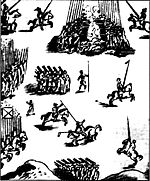Battle of Jaquijahuana
| Battle of Jaquijahuana | |||||||
|---|---|---|---|---|---|---|---|
| Part of the Spanish conquest of Peru | |||||||
 |
|||||||
|
|||||||
| Belligerents | |||||||
| Viceroyalty of Peru | Nueva Castilla | ||||||
| Commanders and leaders | |||||||
|
Pedro de la Gasca Alonso de Alvarado Francisco Hernández Girón |
Gonzalo Pizarro (POW) Francisco de Carvajal (POW) |
||||||
| Strength | |||||||
| 1,600, including 400 cavalry | 900, 6 guns |
||||||
| Casualties and losses | |||||||
| 1 dead | 15 dead, ~800 defected or captured |
||||||
The Battle of Jaquijahuana was fought between the forces of Gonzalo Pizarro and Pedro de la Gasca, on April 9, 1548, during the Conquest of the Inca Empire by the Spanish conquistadores.
After the successful Spanish conquest of the Inca Empire, the assassination of Francisco Pizarro in 1541, and the execution of his main antagonist, Diego de Almagro (1538) and his son, El Mozo (1542), most of the competent commanders of the recently founded New Castile Governorate had been lost in the ensuing power struggle. In 1540, second in line of the Pizarro brothers, Hernando Pizarro, returned to Spain to defend the question of his and his brothers' reign in Peru against accusations of abuse of power. He was eventually imprisoned on orders of King Charles. The Almagristas, followers of Diego de Almagro, met their downfall in the battle of Chupas on September 16, 1542. Two years later, King Charles eventually sent his own envoy, Blasco Núñez Vela, as governor over the recently found Viceroyalty of Peru, and as well to ensure the accomplishment of the New Laws enacted in 1542 to protect the native Peruvian population of Peru.
Gonzalo Pizarro, however, refused to relinquish power and the sovereignty over Peru once belonging to him and his brothers. With his namesake as an ensuring symbol of the former reign of the Pizarros, he gathered supporters, mainly opposed by formal governor of New Castile, Cristóbal Vaca de Castro, victor at Chupas over the Almagristas. The Viceroy arrived at Lima, new capital of Peru, and was sworn into office on May 17, 1544. He shortly after had Castro imprisoned and sent home to Spain. On September 18, Gonzalo Pizarro managed to depose Blasco Núñez Vela and sent him as prisoner to Panama. On October 28, the 1,200 men strong army of Gonzalo Pizarro entered Lima. Upon arrival to Panama, however, Vela was released, and returned to Peru with royal claims as the rightful viceroy and governor of Peru, landing in Tumbes. The two gathered supporters and met on January 18, 1546 at Añaquito in present-day Ecuador, superiority in numbers and firepower ensured victory for Gonzalo Pizarro, who crushed the army of Blasco Núñez Vela, who was decapitated on the field of battle. This, in its turn, ensured a struggle for the control of Peru between Gonzalo Pizarro and the royal forces.
...
Wikipedia
